Boost Your Chatbot’s Success with Data-Driven Analytics
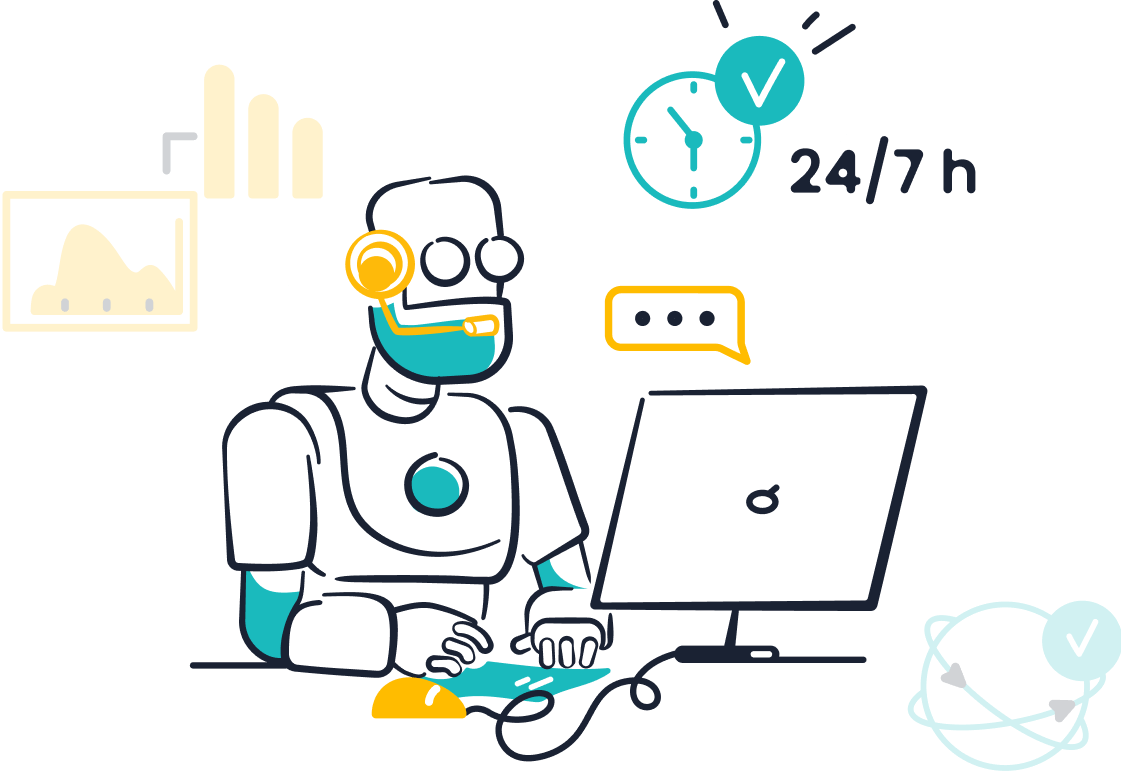
Imagine your chatbot struggling to answer customer questions during a busy sale. Many businesses face this challenge. Tracking and acting on chatbot analytics helps you spot gaps and see real progress. For example:
AI chatbots now handle up to 80% of routine customer inquiries, freeing your agents for complex issues.
Companies like NIB saved $22 million by using chatbot analytics to improve workflows and reduce support needs.
64% of customer experience leaders plan to increase investment in chatbot technology.
With Sobot AI, you can use data, not guesswork, to drive business results and improvement.
Why Analytics Matter

Customer Service Impact
You want your customers to feel heard and helped every time they reach out. Analytics help you see how well your chatbot responds to questions and solves problems. When you use chatbot analytics, you can spot trends, fix weak spots, and improve your customer engagement strategies. Many companies now use analytics to guide their strategies and boost customer satisfaction.
The AI customer service market was valued at $308 million in 2022 and is expected to reach over $3 billion by 2032. This shows rapid growth and trust in these solutions.
AI-powered chatbots can handle up to 70% of customer requests, which means your team spends less time on repetitive tasks.
An average chatbot conversation has only 5.7 messages, so customers get answers faster.
About 80% of customers who use AI chatbots report a positive experience.
Over 63% of retail companies use AI to improve service, showing that analytics-driven strategies are now common.
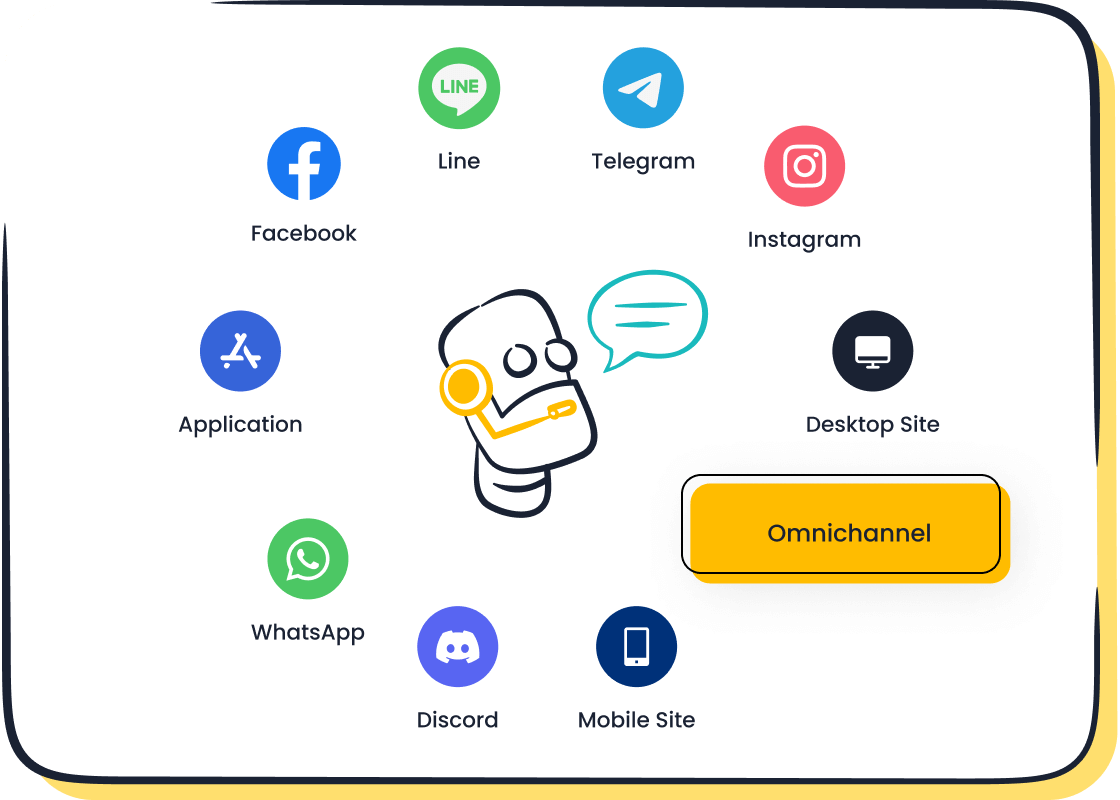
With Sobot, you can track every interaction and use these insights to shape your chatbot strategy. Sobot’s analytics dashboard makes it easy to measure customer satisfaction, resolution rates, and engagement. You can use this data to create enhanced customer engagement and refine your customer engagement strategies.
Business Value
Analytics do more than improve service—they drive real business results. When you use chatbot analytics, you can see where your strategies work and where you need to adjust. Companies that use analytics to guide their chatbot strategy often see higher sales, better efficiency, and stronger customer loyalty.
Here are some real-world examples:
Company / Case Study | Chatbot Solution | Key Numerical Outcome(s) | Business Value Impact Description |
|---|---|---|---|
Lumen Technologies | Microsoft 365 Copilot | ~$50 million annual productivity gain | Time saved per seller (~4 hours/week) and faster content creation led to significant productivity and cost savings. |
LambdaTest | Zoho SalesIQ | 40% increase in operator efficiency | Faster support responses and automated query routing improved operational efficiency. |
Eye-oo (Italy) | Tidio with Lyro AI | €177,000 additional revenue; 25% increase in overall sales | Enhanced cart recovery and product recommendations boosted sales and reduced response times drastically. |
Emirates Vacations | Custom chatbot + ads | 87% increase in consumer engagement | Personalized travel recommendations combined with chatbot ads significantly increased user engagement. |
Sobot’s chatbot analytics help you measure cost savings, conversion rates, and customer loyalty. For example, OPPO used Sobot’s analytics to achieve an 83% chatbot resolution rate and a 57% increase in repurchase rate. When you use analytics to guide your strategies, you can see clear improvements in both service quality and business growth.
Key Metrics
Tracking the right key metrics helps you understand how your chatbot performs and where you can improve. Sobot’s chatbot analytics make it easy to monitor these important numbers in real time. You can use these insights to boost user engagement, increase conversions, and save costs.
Engagement
User engagement shows how much people interact with your chatbot. You can look at user engagement rate, total interactions, and session length. High user engagement means your chatbot keeps users interested and active. For example, a retail company saw a 25% increase in engagement by using personalized chatbot suggestions. Sobot tracks user engagement metrics, so you can see what works best for your audience.
Engagement Metric | Description | Example Impact |
|---|---|---|
User Engagement Rate | Measures how many users interact with the chatbot | 25% increase with personalized suggestions |
Total Interactions | Counts all chatbot conversations | Over 100,000 messages in 5 months (banking case) |
Session Length | Shows how long users stay in a chat | Longer sessions may mean deeper engagement |
Resolution Rate
Resolution rate tells you how often your chatbot solves user problems without help from a human agent. A higher rate means better chatbot performance and happier customers. One company increased its resolution rate from 40% to 75% and saw customer satisfaction rise. OPPO used Sobot’s analytics to reach an 83% chatbot resolution rate, freeing agents for complex issues.
Customer Satisfaction
Customer satisfaction measures how happy users feel after chatting with your bot. You can use surveys like CSAT or NPS to collect feedback. About 77% of customers prefer brands that ask for feedback. Sobot’s analytics let you track these scores and improve your chatbot based on real user input.
Conversion
Conversion tracks how well your chatbot turns conversations into actions, like purchases or sign-ups. Data-driven chatbot strategies can boost conversion rates by up to 68%. Sobot’s analytics show you which flows lead to more sales or leads.
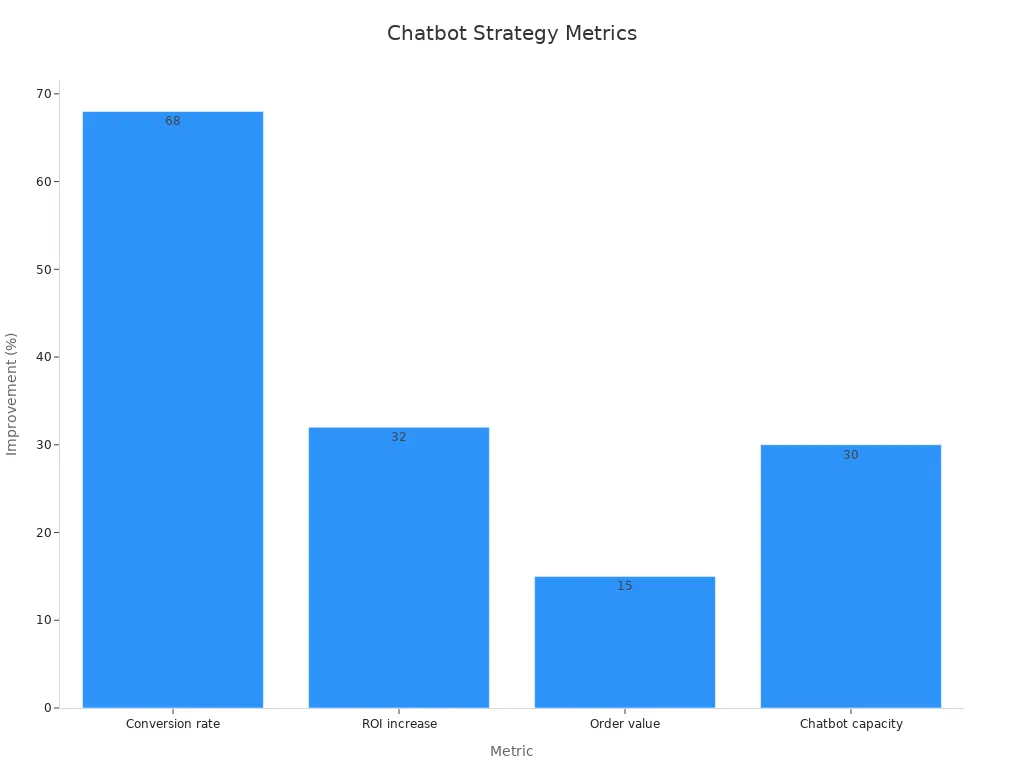
Cost Efficiency
Cost efficiency shows how much money you save by using a chatbot. Sobot’s analytics reveal cost savings per interaction and overall ROI. Some companies report up to 1,275% ROI after using chatbot analytics to optimize their support.
Tip: Use Sobot’s real-time analytics dashboard to track these key metrics and make quick improvements.
Chatbot Analytics Insights

Understanding chatbot analytics insights helps you unlock the full potential of your chatbot. By focusing on trends, user feedback, and continuous testing, you can make smart decisions that lead to better customer experiences and business results. Let’s explore how you can use chatbot analytics insights to drive continuous improvement.
Trend Identification
Spotting trends is one of the most powerful chatbot analytics insights you can use. When you review chatbot analytics, you see patterns in how users interact with your chatbot. These patterns show what works and what needs attention.
Chatbot analytics insights help you benchmark behavior before and after making changes. You can see if coaching or updates lead to better results.
Real-time feedback loops in chatbot analytics insights allow you to adjust quickly and keep improving.
Speaker recognition and detailed reporting in chatbot analytics insights give you a clear view of engagement and conversation quality.
Tools that use conversation intelligence, like Sobot’s analytics dashboard, help you extract actionable chatbot analytics insights for targeted coaching and measurable gains.
You can combine metrics such as goal completion rates, conversation length, and user satisfaction to understand user behavior. Sentiment analysis in chatbot analytics insights reveals if users feel frustrated or happy. If you notice frequent fallback requests, you know where to improve your chatbot’s natural language skills. By using chatbot analytics insights, you can identify trends and make changes that lead to better engagement and higher satisfaction.
Analytics Category | Validated Trend Analysis Techniques |
|---|---|
Customer segmentation, journey mapping, lifetime value analysis, satisfaction measurement | |
Diagnostic Analytics | Root cause analysis, cohort analysis, feedback analysis, benchmarking |
Predictive Analytics | Churn prediction, purchase prediction, sentiment analysis, lifetime value prediction |
Prescriptive Analytics | Segmentation optimization, price optimization, inventory optimization, journey optimization |
Sobot’s omnichannel analytics let you see cross-channel patterns, giving you a complete view of the customer journey. This unified approach makes your chatbot analytics insights even more valuable.
User Feedback
User feedback is a key part of chatbot analytics insights. Every question, answer, and transfer to a human agent gets recorded by your chatbot analytics tools. This data forms the foundation for improvement.
Chatbot analytics insights let you track user satisfaction with surveys like CSAT and NPS.
You can use chatbot analytics insights to spot common complaints or praise, helping you focus on what matters most.
Studies show that chatbots often collect clearer and more specific responses than forms. Users find chatbots easy to use and appreciate features like personalization and gamification.
A well-designed user satisfaction scale, built through careful research, helps you measure how users feel about your chatbot. Sobot’s chatbot analytics insights make it easy to gather and analyze this feedback. You can then use these chatbot analytics insights to update your chatbot and boost satisfaction.
Tip: Use chatbot analytics insights to review feedback regularly. This helps you spot trends and act quickly to improve your chatbot.
Continuous Testing
Continuous testing is essential for strong chatbot analytics insights. By testing your chatbot often, you make sure it stays accurate and helpful.
Chatbot analytics insights track metrics like accuracy, precision, recall, F1-score, and response time.
Automated testing pipelines use chatbot analytics insights to monitor these metrics and keep your chatbot performing well.
Practices like regression testing, performance testing, and A/B testing all rely on chatbot analytics insights for data-driven decisions.
Metric | Description |
|---|---|
Accuracy | Measures how many chatbot responses are correct. |
Precision | Shows how many relevant answers the chatbot gives. |
Recall | Checks if the chatbot finds all important answers. |
F1-score | Balances precision and recall for a full view. |
Response Time | Tracks how fast the chatbot replies. |
User Satisfaction | Measures how happy users are with the chatbot. |
A leading e-commerce company saw a 40% jump in successful query resolutions after using continuous testing and chatbot analytics insights. This led to better understanding of customer needs and more personalized recommendations.
Sobot’s chatbot analytics insights support continuous improvement by making it easy to test, measure, and refine your chatbot. You can set up automated tests and review chatbot analytics insights in real time. This ensures your chatbot always delivers high-quality service.
Note: Continuous improvement depends on regular review of chatbot analytics insights. Make testing and feedback part of your routine for the best results.
Optimize with Sobot
Optimizing your chatbot with Sobot gives you a clear path to better results. You can use chatbot analytics to set goals, improve flows, and update training data. Sobot’s no-code tools and unified analytics make this process simple and effective. Here’s a step-by-step guide to implementing chatbot analytics for ongoing success.
Set Goals
Start by setting clear goals for your chatbot. Decide what you want to achieve, such as higher customer satisfaction, faster response times, or more sales. Use chatbot analytics to track your progress. Sobot’s dashboard lets you see important metrics in real time. You can measure things like resolution rate, customer satisfaction, and conversion.
Here is a table showing how Sobot’s optimization solutions have led to measurable improvements for different customers:
Metric / Customer | Improvement / Result |
|---|---|
Agent workload reduction (AI Copilot) | 60% decrease |
Conversion rate increase | 15% increase |
Net Promoter Score (NPS) improvement | 35% increase |
Resolution time | Reduced to under 1 minute |
J&T Express sign-off rate | 35% increase |
J&T Express COD collection rate | 40% increase |
OPPO customer satisfaction (CSAT) | 93% achieved |
Agilent customer service efficiency | 6x increase |
You can see these improvements visually:
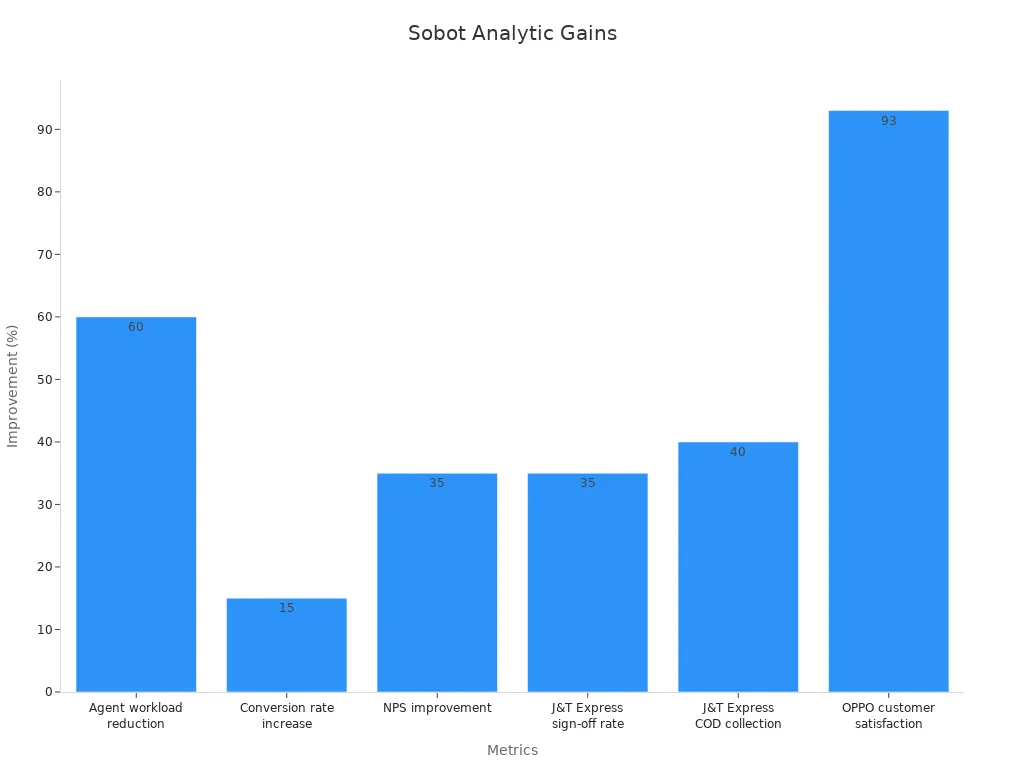
Tip: Use Sobot’s analytics to set specific, measurable goals. This helps you focus your chatbot strategy and improve performance over time.
Improve Flows
Improving your chatbot flows means making conversations smoother and more helpful. Use chatbot analytics to find where users get stuck or drop off. Sobot’s no-code interface lets you adjust flows quickly, without needing to code. You can test different versions and see which one works best.
Key metrics to watch include flow completion rate, fallback rate, customer satisfaction, human takeover rate, retention, and leads captured. These numbers show how well your chatbot guides users and where you can make changes.
A/B testing lets you compare different chatbot flows and pick the one that performs better.
Analytics help you spot friction points, like high drop-off rates or frequent human handovers.
Feedback loops between analytics and training data help your chatbot learn and improve.
Focus your efforts on changes that boost user satisfaction and business results.
Machine learning and predictive analytics help your chatbot anticipate needs and personalize conversations.
Sobot’s omnichannel integration means you can track and optimize flows across all your customer channels. This unified view helps you deliver a consistent and high-quality experience everywhere.
Note: Improving user experience starts with understanding your analytics. Use Sobot’s tools to make data-driven changes that matter.
Update Training Data
Updating your chatbot’s training data is key to keeping it accurate and helpful. Chatbot analytics show you which questions your chatbot struggles with. You can use this information to add new examples and improve intent recognition.
Studies show that updating training data leads to big gains in chatbot performance. For example, a medical chatbot doubled its accuracy after adding more diverse data. Industry reports say that 80% of AI project time goes into preparing and cleaning data. High-quality, updated data helps your chatbot give better answers and reduces errors. One efficient way to gather fresh and diverse training inputs is by using a web scraping API to automatically collect relevant content from forums, reviews, or knowledge bases. This expands your dataset with real-world user language and improves your chatbot’s intent coverage.
As for internal knowledge, Sobot makes it easy to update training data. You can upload new FAQs, product info, or customer feedback with just a few clicks. The system supports multiple languages and channels, so your chatbot stays smart and relevant everywhere.
Tip: Review your chatbot analytics often. Update your training data regularly to keep improving performance and customer satisfaction.
Sobot’s No-Code Optimization and Unified Analytics
Sobot’s no-code optimization tools let you make changes fast. You do not need to write code or wait for IT support. The reporting features give you instant insights into chatbot analytics, so you can act quickly.
Here is a table showing the benefits of Sobot’s no-code optimization and reporting:
Benefit Area | Quantitative Metric/Impact |
|---|---|
Customer Interaction Handling | Voice AI agents handle over 50% of interactions instantly |
Sales Improvement | Automated outbound marketing improves sales by 30%+ |
Customer Service Automation | Automating 50% of support can save $6,250 |
Agent Efficiency | AI Copilot reduces repetitive tasks and speeds responses |
Reporting & Optimization | AI Insight gives instant, detailed dashboards |
Sobot’s omnichannel integration brings all your analytics together. You get a single view of your chatbot’s performance across chat, voice, email, and more. This helps you spot trends, set better goals, and improve performance everywhere.
Callout: Sobot’s unified analytics and no-code tools make it easy for you to optimize your chatbot, save time, and boost results.
If you want to improve performance and see real business impact, follow this step-by-step guide to implementing chatbot analytics. Set clear goals, improve flows, and update training data. Use Sobot’s powerful tools to make every step simple and effective. This approach will help you build a winning chatbot strategy and keep improving user experience.
Tools and Integration
Analytics Dashboards
You need clear, real-time insights to make your chatbot smarter. Analytics dashboards give you a complete view of how your chatbot performs. With Sobot, you can track key metrics like active users, session length, user ratings, and fallback responses. These dashboards help you spot trends, measure success, and find areas to improve. For example, a travel agency used analytics dashboards to reduce booking drop-offs by 25%. Retailers have seen a 20% increase in completed transactions after refining their chatbot flows. Sobot’s dashboards also let you compare performance across channels, so you always know where your chatbot stands.
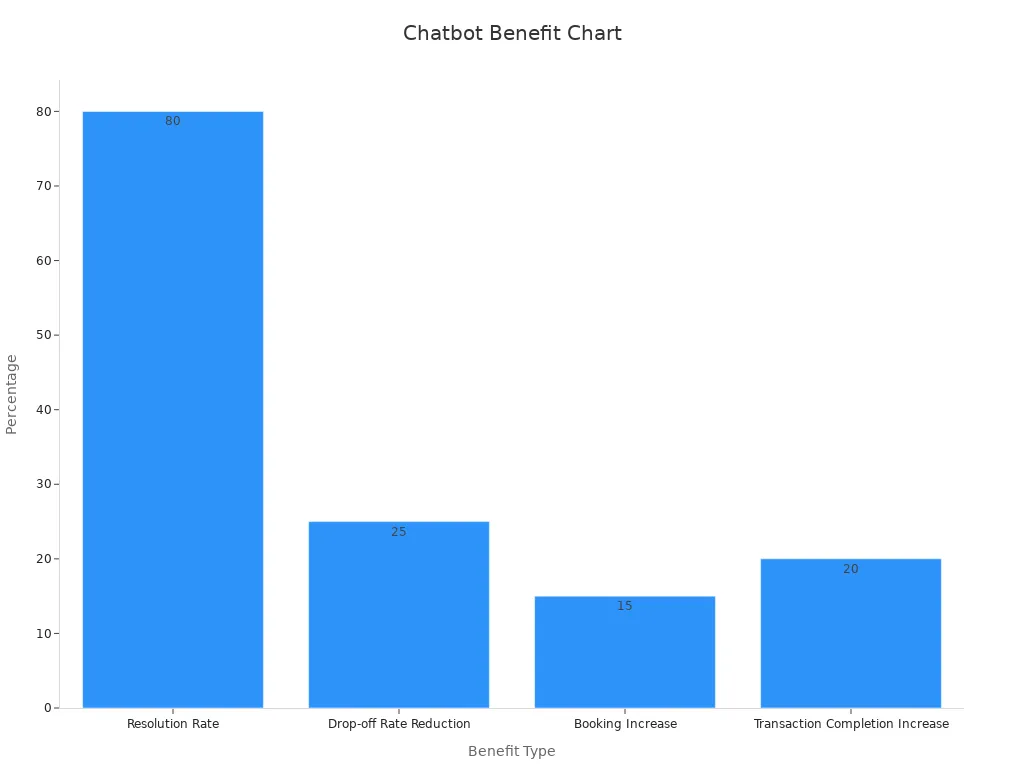
Measurable Benefit | Description / Example |
|---|---|
Resolution Rate | 80% of queries resolved without human help, saving time and money. |
Conversion Rate Increase | Personalized recommendations boost sales and sign-ups. |
Customer Satisfaction (CSAT) | High CSAT scores show users are happy with chatbot support. |
Cost Reduction | Handling FAQs with chatbots lowers support costs. |
Workflow Integration
You can boost efficiency by connecting chatbot analytics tools with your other business systems. Sobot makes it easy to link your chatbot with CRM, ticketing, and knowledge bases. This integration lets you automate tasks like ticket routing, knowledge updates, and proactive follow-ups. For example, healthcare providers use chatbots to automate patient registration and billing, which reduces staff workload. Automotive companies use chatbots to match customers with dealerships and schedule test drives, saving time and improving service. Sobot’s workflow integration helps you turn analytics into action, making your support team more productive.
Automated ticket routing and proactive alerts improve customer satisfaction.
Integration with CRM gives you a full view of each customer’s journey.
Data Security
You want your data to stay safe. Sobot protects your analytics and customer information with strong security measures. The platform uses encryption and follows strict privacy rules to keep your data secure. Only authorized users can access sensitive analytics dashboards and chatbot analytics tools. This means you can trust Sobot to handle your business data responsibly. Data security is a top priority, so you can focus on improving your chatbot without worry.
Tip: Always review who has access to your analytics dashboards and update permissions regularly.
Overcoming Challenges
Data Quality
You need high-quality data to get the most from your chatbot. Poor data can lead to inaccurate answers and missed opportunities. Studies show that even when chatbots reach over 90% accuracy in some fields, problems like inconsistent responses and unreliable training data still exist. For example, in climate change topics, chatbot accuracy was about 89.9%, while in mental health, it reached 92.5%. However, chatbots often give the same answer to everyone, missing important details for different users.
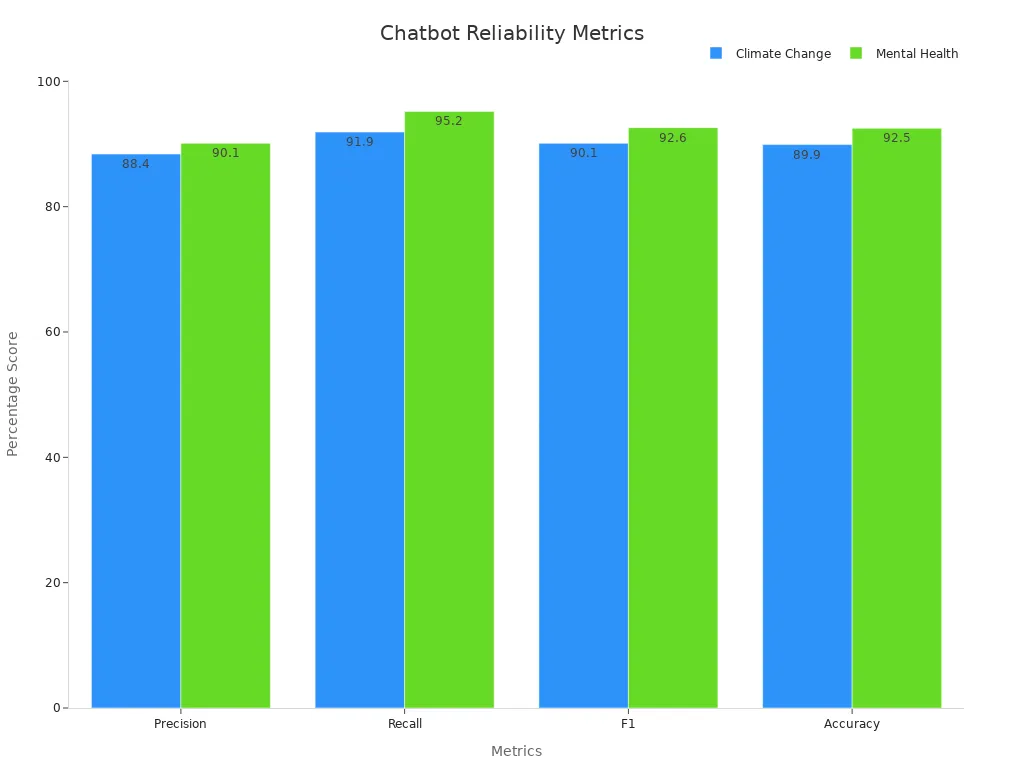
To keep your data strong, you should:
Cleanse your data by fixing mistakes and removing duplicates.
Validate your data by checking it against trusted sources.
Use data governance to set clear rules and standards.
Monitor your data with real-time checks and regular audits.
Sobot’s analytics tools help you manage these steps, making sure your chatbot stays reliable and accurate.
Team Alignment
Your team needs to work together to get the best results from your chatbot strategies. When everyone uses the same analytics, you can spot problems and fix them faster. Teams that align their strategies with data-driven insights see big gains. For example, an online retailer increased completed transactions by 20% after updating chatbot scripts based on analytics. A travel agency boosted bookings by 15% by using analytics to promote the right travel packages.
Here are ways to keep your team aligned:
Share analytics dashboards so everyone sees the same data.
Hold regular meetings to review chatbot performance.
Update your strategies often based on analytics insights.
Use AI to predict user needs and adjust your strategy.
Sobot’s unified analytics platform makes it easy for your team to stay on the same page and act quickly.
Measuring ROI
You want to know if your chatbot strategies pay off. Measuring ROI helps you see the value of your investment. Use clear metrics like cost savings, sales conversions, and customer satisfaction. For example, a company that invested $30,000 in chatbot analytics saw $90,000 in annual benefits, which is a 200% ROI.
Tracking Area | Key Metrics | Measurement Frequency |
|---|---|---|
Cost Savings | Labor hours saved, reduced expenses | Monthly |
Revenue Impact | Sales conversions, order value | Weekly |
Customer Service | Resolution rates, response times | Daily |
Overall ROI | Cost-benefit analysis | Quarterly |
Sobot’s analytics dashboards let you track these numbers in real time. You can see how your strategies improve efficiency and boost your bottom line.
You can drive real improvement in your chatbot by tracking the right metrics. Focus on conversation completion, first-contact resolution, CSAT, retention, and conversion rates. These numbers show where your chatbot succeeds and where you can grow. Sobot gives you easy-to-use analytics tools that help you spot trends and act fast. Start by reviewing your current analytics dashboard or setting a new performance goal. Small steps lead to big gains in customer satisfaction and business results.
Key metrics to watch:
Conversation completion rate
First-contact resolution
Retention and conversion rates
Escalation rate
Tip: Use Sobot’s analytics to review these metrics regularly for ongoing improvement.
FAQ
What are the most important key metrics to track for chatbot performance?
You should track user engagement rate, resolution rate, customer satisfaction, and conversion. These key metrics help you see how well your chatbot supports users. Sobot’s analytics dashboards make it easy to monitor these numbers and spot areas for improvement.
How can I improve performance and customer experience with chatbot analytics tools?
You can use chatbot analytics tools to find weak spots in your flows. For example, Sobot’s real-time dashboards show where users drop off. You can then adjust your strategy and test changes. This step-by-step guide to implementing chatbot analytics leads to continuous improvement and better customer experience.
Why does user engagement matter for driving business results?
User engagement shows how much people interact with your chatbot. High user engagement metrics often mean users find value. Sobot helps you boost engagement by offering enhanced customer engagement features. Strong engagement supports your customer engagement strategies and drives business results.
How does Sobot support continuous improvement in chatbot strategy?
Sobot gives you easy tools to update training data and test new flows. You can review analytics after each change. This process supports continuous improvement and helps you build a strong chatbot strategy that adapts to user needs.
Can Sobot help with improving user experience across channels?
Yes. Sobot’s omnichannel integration lets you track analytics from chat, voice, and email in one place. You can see trends and make changes that improve performance everywhere. This unified view helps you deliver a better user experience.
See Also
Ways Chatbots Enhance Customer Experience In Online Shopping
Step By Step Guide To Building A Successful Chatbot
Key Advantages Of Integrating Chatbots Into Your Website
